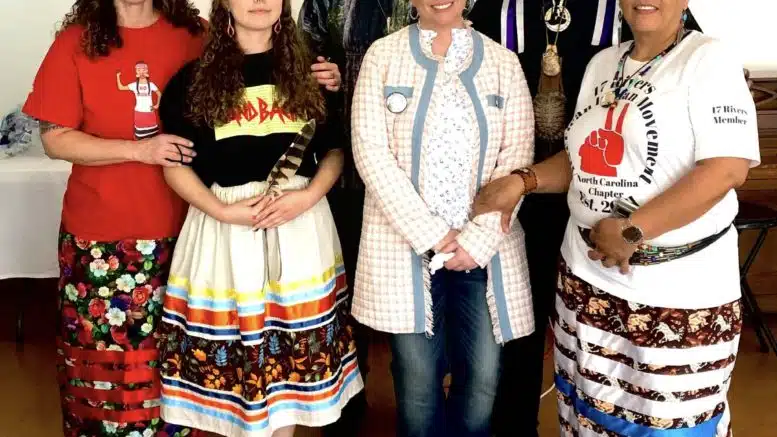By Will Atwater
Before Europeans came to North Carolina, the Skarure Woccon tribe (Cape Fear Indians) sustained themselves by hunting, fishing and harvesting herbs and other plants in the lower Cape Fear River Basin.
More popularly known as Tuscarora Indians, many tribal members continue to live spread across land, including Bladen, Columbus and Pender counties, where they still follow cultural traditions. Some tribal members fish in the Cape Fear River, hunt on adjacent land and harvest wild plants for food, healing and rituals.
However, a chemical commercially known as GenX in the river may force members of the tribe to reconsider long-held cultural practices to protect their health.
“Our life force was the Cape Fear River, going all the way back traditionally, before colonization. The rivers of North Carolina, that was our travel ways, that’s the way we got to other destinations,” said Jane Jacobs (EagleHeart).
“We hunted and fished all up and down the rivers. And so it’s kind of like we’re having a problem making our people understand that we can no longer do the things we used to do, we can no longer go to the river and harvest medicine because now it’s polluted,” she added.
Six years after GenX chemicals were discovered in the Cape Fear River, roughly 25 members of the Skarure Woccon tribe gathered at Lake Waccamaw’s First Baptist Church on Earth Day to discuss the tribe’s history and to hear about a study of what kinds of exposure people in the area are experiencing. Many tribal members rely on the river for sustenance, and extended exposure to GenX chemicals could lead to adverse health outcomes, Lovell Pierce Moore (Chief EagleElk) said. So the time to act is now.
“A lot of people here don’t know how urgent [the situation] is and that a lot of the illnesses that we attribute to old age and things of that nature are actually from poisoning because everybody’s still eating out of the river,” she said. “Now we’re finding [GenX] in the gators in Lake Waccamaw. We haven’t had any wells tested, but if it’s in the gators, it’s safe to assume it’s in the people.”
Spreading the word about GenX
GenX is a class of per- and polyfluoroalkyl substances (PFAS) manufactured by Chemours at its Fayetteville Works facility. Commonly referred to as “forever chemicals” for their persistence in the human body, more than 12,000 PFAS compounds exist and are used in nonstick cookware, cosmetics, cleaning products, water-resistant clothing and textiles, some firefighting foams and firefighting turnout gear.
Beth Kline-Markesino, founder of North Carolina Stop GenX in our Water, a nonprofit advocacy group, organized the April 22 event and also believes the meeting was essential for the tribe to forge relationships with researchers who may assist them in the future as building a rapport and establishing trust with outsiders can take time.
“I’ve been affiliated with the tribe for probably over seven years now, and we were talking about GenX and possibly seeing if we can do some studies with the tribe — testing not only their blood but also their soil, the fish and animals that they hunt and also the food that they grow,” Kline-Markesino said.
One of those researchers is Jane Hoppin, an epidemiologist from NC State who is leading the GenX Exposure Study, a large effort to look at the health effects in people exposed to PFAS.
Hoppin presented information about the study and answered questions for roughly 30 to 45 minutes, she said.
“I appreciated the opportunity to share what we had learned about GenX and PFAS in this community that really hadn’t been receiving information from us broadly,” Hoppin said.
While there is no definitive evidence about the health risks PFAS pose to humans, there is mounting research that suggests links between extended exposure to forever chemicals and weaker antibody responses against infections, elevated cholesterol levels, decreased infant and fetal growth, and kidney and testicular cancer in adults.
GenX compounds were found in Wilmington’s municipal water supply in 2017. The GenX Exposure Study started in 2018, when researchers collected blood samples from Wilmington residents.
In 2019, Chemours, NC DEQ and Cape Fear River Watch signed a consent order, which required Chemours, among other things, to develop and execute a PFAS remediation plan for contaminated air, soil and water for the affected lower Cape Fear River Basin communities.
Researchers extended the study in 2020 to include Fayetteville and Pittsboro residents, who also receive drinking water from the Cape Fear River.
In 2022, the U.S. Environmental Protection Agency set a drinking water health advisory for GenX compounds at 10 parts per trillion, and researchers presented study findings that showed the presence of legacy PFAS (PFOA, PFOS, PFHxS, PFNA) in the blood of Wilmington study participants at a level above the national average.
Earlier this year, the EPA proposed National Primary Drinking Water Regulation for a half dozen per- and polyfluoroalkyl substances. The list includes perfluorooctanoic acid (PFOA), perfluorooctane sulfonic acid (PFOS), perfluorononanoic acid (PFNA), hexafluoropropylene oxide dimer acid (HFPO-DA, commonly known as GenX chemicals), perfluorohexane sulfonic acid (PFHxS) and perfluorobutane sulfonic acid (PFBS).
Contaminated fish
Concerns about PFAS contamination in the river, the soil and plants will likely require Skarure tribal members to reconsider how they interact with the land.
“We can’t eat the fish, [but] we’re still seeing people doing these things, so that’s where our concern comes in,” Jacobs said.
“Our people are still pulling buckets full of crappy out the Cape Fear River, catching big old catfish, taking them home and cooking them up. Catfish are bottom-dwellers, so you can be sure their toxin level is huge.”
Jacobs has cause to be concerned. A recently released study of freshwater fish nationwide supports her concerns. Freshwater fish across the U.S. “are likely a significant source of exposure to PFOS and other perfluorinated compounds,” according to the report.
Subsistence fishing is the term used to describe people who rely on the fish that they catch to feed themselves, their family or their community members. NC State researcher Scott Belcher, whose research led to the discovery of elevated levels of PFAS in the blood of alligators in the Cape Fear River and Lake Waccamaw, says there are thousands of subsistence anglers in North Carolina.
Currently, Belcher is studying fish that are primarily located in “the upper Cape Fear, but [is] looking to collaborate with local/regional tribes,” he said by email.
Tribal leaders are also concerned that area plants, such as false nettle or bog hemp, used for healing and protection, might be contaminated with PFAS.
Securing land, cleaning the water
It’s unclear whether the Skarure Woccon tribe will be a part of the next phase of the GenX Exposure Study. However, one thing is clear: The tribe and its supporters are working on securing resources to fund well water testing. Pierce Moore said that many tribal members live in rural communities and rely on well water that they fear is contaminated.
It’s suspected that well water has become tainted by groundwater contamination and by PFAS that went up the smokestack at Chemours for years and then settled on land downwind.
Chemours is required by their consent decree to provide well water testing in the region and remediation support for wells with GenX levels greater than 10 parts per trillion, but Pierce Moore says that many tribal members live outside of the testing radius. Therefore, the cost for testing falls on individual well owners.
Pierce Moore said that there’s a company that has the technology needed to purify well water, but substantial resources are needed to sustain the tribe long term.
Sign up for our Newsletter
“We have tribal members from other areas and other states who want to move here, but they’re afraid of the water. What are they going to do?” he asked. “You know, we have to depend on buying water. What about your bathing and dishes and things of that nature?
”We have to clean this stuff up, and [resources] will help us do that.”
Underscoring the need for well testing is the National Ground Water Association’s recent recommendation that private well owners should have their wells inspected annually due, in part, to the rise of emerging contaminants such as PFAS, according to a news release.
Securing resources needed to purchase technology to remove PFAS compounds on a large-scale level may take time. But there is an immediate goal tribal leaders and supporters are trying to reach: supplying families with filters for their homes. Recently, Jacobs received a grant for $6,500 to purchase filters, but more are needed.
“How am I going to give a filter to one family unit and not have enough to give to their neighbor?” asked Jacobs. She wants to supply each residence with two filters — one for under the kitchen sink and one for the shower, and two replacement filters for each device. Jacobs is not yet sure how many filters she’ll be able to install and continues to seek more funding.
One challenge for securing and distributing filters is figuring out how to separate out tribal members who live in areas where the consent decree requires Chemours to test well water, and who lives in a city such as Wilmington where the water utility installed a filtration system that cleans the municipal water supply, said Katy May, co-director for the Center for Human Health and the Environment at NC State.
From invisible to visible
Pierce Moore says he, like other anti-PFAS advocates, wants Chemours to suffer financial consequences for polluting the water and the land, which he alleges has caused community members to develop cancer and thyroid problems, along with other illnesses. Pierce Moore also advocates for tribal land ownership as part of the land recovery and healing process.
May facilitates relationships between university scientists who study PFAS and affected communities. She agrees with others that the meeting was essential for future collaborations with the tribe. A moment from the event that stands out to May was when Chief Pierce Moore told the audience that he was working to make invisible people seen.
“If you treat people as invisible, then you don’t have to address their needs,” May said. “If people aren’t here, you don’t have to worry about if they’re drinking contaminated water.”
Jacobs spoke about the potential impact of ongoing partnerships with scientists and researchers. She said the perfect scenario would be if “we all work together for the protection of the Earth Mother and the next seven generations that’ll be walking upon the earth.”









